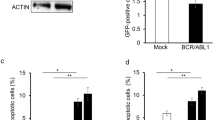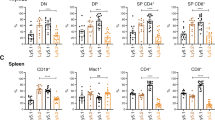Abstract
In Burkitt's lymphoma (BL) cells due to a t(8;14) chromosomal translocation c-myc is often placed in proximity to the Eμ enhancer of the Ig locus and upregulated. We demonstrated that in BL cells a peptide nucleic acid (PNA), complementary to intronic Eμ sequences (PNAEμwt), specifically blocks the expression of the c-myc oncogene under the Eμ enhancer control and inhibits BL cell growth in culture. Here, we investigated whether PNAEμwt was also able to block tumor growth in SCID mice inoculated with human BL cell lines. After subcutaneous inoculum in mice BL cells reproducibly form tumors. Both pre-treatment of BL cells with PNAEμwt before inoculum and chronic intravenous administration of PNAEμwt to mice already inoculated with BL cells selectively caused increased latency of tumor appearance and decreased final tumor size. Tumors from PNAEμwt-treated animals showed substantial areas of cell necrosis and of c-myc downregulation. Inhibition of tumor growth was specific and was not observed with PNAEμmut carrying sequence mutations and in BL cell lines where the translocated c-myc is not under the control of the Eμ enhancer. These data confirm the potential therapeutic value of PNA targeted to regulatory non-coding regions.
This is a preview of subscription content, access via your institution
Access options
Subscribe to this journal
Receive 12 print issues and online access
$259.00 per year
only $21.58 per issue
Buy this article
- Purchase on Springer Link
- Instant access to full article PDF
Prices may be subject to local taxes which are calculated during checkout


Similar content being viewed by others
Accession codes
References
Nielsen PE . Peptide nucleic acid targeting of double-stranded DNA. Methods Enzymol 2001; 340: 329–340.
Cutrona G, Carpaneto EM, Ulivi M, Roncella S, Landt O, Ferrarini M et al. Effects in live cells of a c-myc anti-gene PNA linked to a nuclear localization signal. Nat Biotech 2000; 18: 300–303.
Magor BG, Ross DA, Pilstrom L, Warr GW . Transcriptional enhancers and the evolution of the IgH locus. Immunol Today 1999; 20: 13–17.
Cutrona G, Carpaneto EM, Ponzanelli A, Ulivi M, Millo E, Scarf S et al. Inhibition of the translocated c-myc in Burkitt's lymphoma by a PNA complementary to the Eμ enhancer. Cancer Res 2003; 63: 6144–6148.
Boffa LC, Cutrona G, Cilli M, Mariani MR, Matis S, Pastorino M et al. Therapeutically promising PNA complementary to a regulatory sequence for c-myc: pharmacokinetics in an animal model of human Burkitt's Lymphoma. Oligonucleotides 2005; 15: 85–93.
Roncella S, Cutrona G, Favre A, Ulivi M, Fais F, Signorini A et al. Apoptosis of Burkitt's lymphoma cells induced by specific interaction of surface IgM with a self-antigen: implication for lymphomagenesis in acquired immunodeficiency syndrome. Blood 1996; 15: 599–608.
Shiramizu B, Barriga F, Neequaye J, Jafri A, Dalla Favera R, Neri A et al. Patterns of chromosomal breakpoint locations in Burkitt's lymphoma: relevance to geography and Epstein-Barr virus association. Blood 1991; 77: 1516–1526.
Ogden CA, Pound JD, Batth BK, Owens S, Johannessen I, Wood K et al. Enhanced apoptotic cell clearance capacity and B cell survival factor production by IL-10-activated macrophages: implications for burkitt's lymphoma. J Immunol 2005; 174: 3015–3023.
Cutrona G, Ulivi M, Fais F, Roncella S, Ferrarini M . Transfection of the c-myc oncogene into normal Epstein–Barr virus-harboring B cells results in new phenotypic and functional features resembling those of Burkitt lymphoma cells and normal centroblasts. J Exp Med 1995; 18: 699–711.
Sidman CL, Shaffer DJ, Jacobsen K, Vargas SR, Osmond DG . Cell populations during tumorigenesis in Eμ-myc transgenic mice. Leukemia 1993; 7: 887–895.
Acknowledgements
This work was supported by grants by Associazione Italiana per la Ricerca sul Cancro (MF), Project AIDS Grant 30D-30 (MF), Fondo Investimenti Ricerca di Base (FIRB) RBAU01R5SE (MF, LCB); CIPE, 2004:CBA Project (GC, LCB); National Research Program ‘Technologies in Oncology’ Theme12 (MF, LCB), Salute 2005 (LCB, GC); (AIL): Associazione Italiana Leucemie, Sez. Francesca Lanzone, SP (SR); RBNE01TBTR-003 (U Benatti); Istituto Superiore di Sanità. We thank Dr EM Carpaneto for reviewing the manuscript. We also acknowledge the excellent technical support of Ms Lorella Pecunia in histological preparations and of the PDTC, The Rockefeller University, New York, NY in PNA characterization and purification.
Author information
Authors and Affiliations
Corresponding author
Rights and permissions
About this article
Cite this article
Boffa, L., Cutrona, G., Cilli, M. et al. Inhibition of Burkitt's lymphoma cells growth in SCID mice by a PNA specific for a regulatory sequence of the translocated c-myc. Cancer Gene Ther 14, 220–226 (2007). https://doi.org/10.1038/sj.cgt.7701002
Received:
Revised:
Accepted:
Published:
Issue Date:
DOI: https://doi.org/10.1038/sj.cgt.7701002
Keywords
This article is cited by
-
Peptide-mediated Cell and In Vivo Delivery of Antisense Oligonucleotides and siRNA
Molecular Therapy - Nucleic Acids (2012)
-
PNAEμ can significantly reduce Burkitt's lymphoma tumor burden in a SCID mice model: cells dissemination similar to the human disease
Cancer Gene Therapy (2009)



